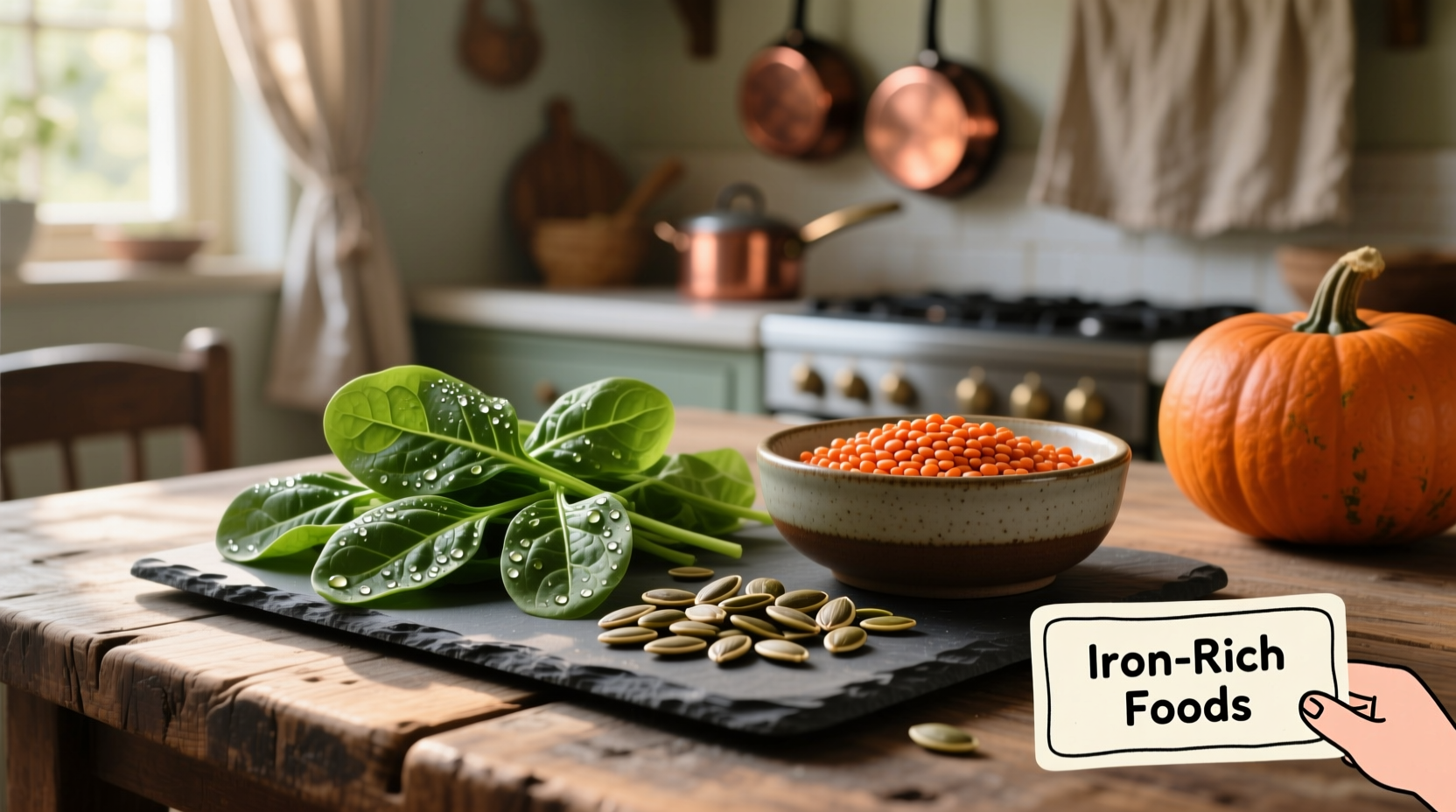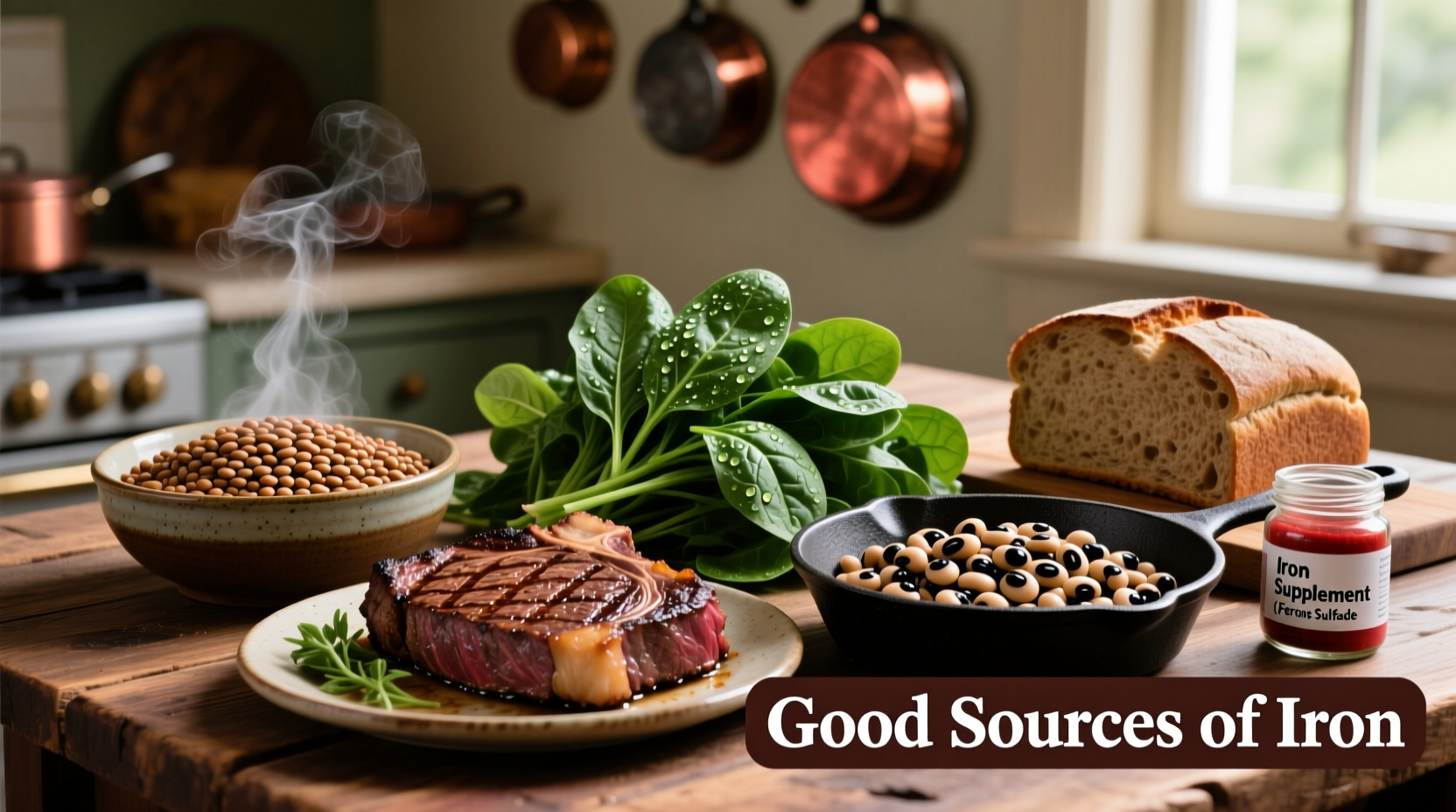Spinach, red meat, lentils, pumpkin seeds, and quinoa rank among the top iron-rich foods. A 3-ounce serving of beef provides 2.1 mg of highly absorbable heme iron, while one cup of cooked spinach delivers 6.4 mg of non-heme iron. Pairing plant-based iron sources with vitamin C-rich foods like citrus fruits can boost absorption by up to 300%, according to the National Institutes of Health.
Iron deficiency affects approximately 1.2 billion people worldwide, making it the most common nutritional deficiency globally (World Health Organization, 2023). Understanding which foods deliver optimal iron intake—and how to maximize absorption—can transform your energy levels and overall health. This guide reveals the science-backed iron sources that deliver measurable benefits, plus practical strategies to incorporate them into your daily meals.
Why Iron Matters More Than You Think
Iron serves as the essential building block for hemoglobin, the protein in red blood cells that transports oxygen throughout your body. Without adequate iron, your cells become oxygen-starved, leading to fatigue, weakened immunity, and cognitive impairment. The Recommended Dietary Allowance (RDA) varies significantly by demographic:
| Demographic Group | Daily Iron Requirement | Primary Source Considerations |
|---|---|---|
| Men (19-50 years) | 8 mg | Easily met through varied diet |
| Women (19-50 years) | 18 mg | Menstrual losses increase needs |
| Pregnant Women | 27 mg | Supports fetal development |
| Vegans/Vegetarians | 1.8x higher | Non-heme iron requires strategic pairing |
This data from the NIH Office of Dietary Supplements highlights why personalized iron strategies matter. Women of childbearing age need more than double the iron of men in the same age group, while plant-based eaters require nearly twice the intake due to lower absorption rates of non-heme iron.
Heme vs. Non-Heme Iron: The Absorption Difference
Understanding the two types of dietary iron explains why some foods deliver better results than others:
- Heme iron (from animal sources): 15-35% absorption rate, unaffected by other dietary factors
- Non-heme iron (from plant sources): 2-20% absorption rate, significantly influenced by food combinations
While plant-based iron sources contain higher absolute amounts, their bioavailability remains the critical factor. This explains why someone eating spinach daily might still develop deficiency without proper pairing strategies.
Top 7 Iron Powerhouses Ranked by Practical Benefit
Animal-Based Iron Sources
1. Oysters (3 oz) - 8 mg iron (45% DV) Oysters deliver exceptional iron density along with zinc and vitamin B12. Their heme iron achieves approximately 25% absorption—making them one of the most efficient single-food iron sources available.
2. Grass-Fed Beef (3 oz) - 2.1 mg iron (12% DV) The myoglobin in red meat creates highly bioavailable heme iron. Opt for grass-fed varieties which contain additional conjugated linoleic acid (CLA) that supports metabolic health.
Plant-Based Iron Sources
3. Lentils (1 cup cooked) - 6.6 mg iron (37% DV) These legumes offer the best combination of iron density and practicality. Unlike spinach, lentils maintain their iron content during cooking and provide substantial fiber and protein.
4. Pumpkin Seeds (1 oz) - 2.5 mg iron (14% DV) A convenient snack option that delivers iron alongside magnesium and zinc. Toasting enhances both flavor and nutrient availability.
5. Spinach (1 cup cooked) - 6.4 mg iron (36% DV) Cooking concentrates the iron while reducing oxalates that inhibit absorption. Always pair with vitamin C for maximum benefit.
6. Quinoa (1 cup cooked) - 2.8 mg iron (16% DV) This complete protein stands out among grains for its iron content and amino acid profile, making it ideal for plant-based diets.
7. Dark Chocolate (1 oz, 70-85% cocoa) - 3.4 mg iron (19% DV) An unexpected but potent source that also provides magnesium and flavonoids. Choose minimally processed varieties for optimal nutrient retention.

Strategic Pairing: Maximizing Your Iron Uptake
Simply consuming iron-rich foods isn't enough—how you combine them determines actual nutritional benefit. Research from Harvard T.H. Chan School of Public Health demonstrates these evidence-based strategies:
- Vitamin C pairing: Adding 100mg of vitamin C (about half a bell pepper) can increase non-heme iron absorption by 300% (NIH, 2022)
- Avoid tea/coffee with meals: Tannins can reduce iron absorption by up to 60% (American Journal of Clinical Nutrition)
- Cook in cast iron: Acidic foods like tomato sauce can absorb significant iron during cooking
- Soak legumes: Reduces phytates that inhibit iron absorption by 50% or more
Practical application: Try a spinach salad with lemon vinaigrette and strawberries, or lentil soup with tomatoes and bell peppers. These combinations transform theoretically good iron sources into highly effective nutritional solutions.
Special Considerations for Different Diets
For Plant-Based Eaters
Vegans and vegetarians face unique challenges since they rely solely on non-heme iron. The solution requires strategic planning:
- Consume 1.8 times the standard RDA to compensate for lower absorption
- Include fermented foods like tempeh which reduce absorption inhibitors
- Rotate iron sources throughout the day rather than concentrating in one meal
- Monitor calcium intake timing—separate from iron-rich meals by 2-3 hours
For Athletes and Active Individuals
Endurance athletes lose iron through sweat, foot strike hemolysis, and increased metabolic demands. A study in the Journal of Sports Sciences found female runners required 70% more iron than sedentary women. Incorporate iron-rich snacks like trail mix with pumpkin seeds and dried apricots post-workout.
When Food Isn't Enough: Recognizing Deficiency
Despite dietary efforts, some situations require medical intervention. Warning signs include:
- Persistent fatigue that doesn't improve with rest
- Pale skin and brittle nails
- Shortness of breath during mild activity
- Unusual cravings for ice or dirt (pica)
If you experience these symptoms despite consuming iron-rich foods, consult a healthcare provider. Blood tests measuring serum ferritin (iron stores) and transferrin saturation provide definitive diagnosis. Never self-treat with supplements without medical guidance, as excess iron causes serious health complications.
Building Your Iron-Rich Meal Plan
Implement these practical strategies to boost your iron intake without drastic dietary changes:
- Breakfast: Quinoa porridge with pumpkin seeds and orange slices
- Lunch: Lentil soup with tomato base and bell peppers
- Snack: Dark chocolate with strawberries
- Dinner: Grass-fed beef stir-fry with broccoli and red bell peppers
This sample day delivers approximately 25 mg of iron with optimal absorption enhancers at each meal—meeting 140% of the standard RDA while remaining practical for daily implementation.











 浙公网安备
33010002000092号
浙公网安备
33010002000092号 浙B2-20120091-4
浙B2-20120091-4